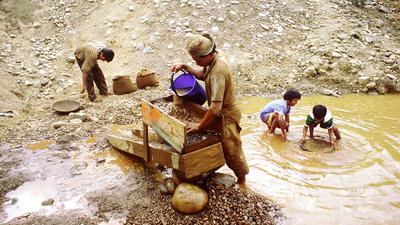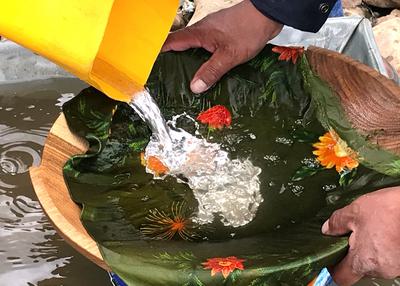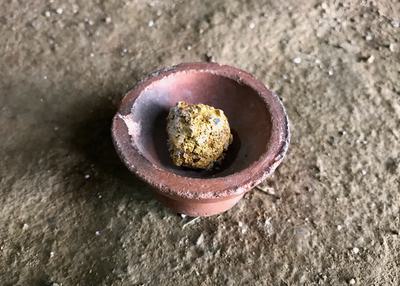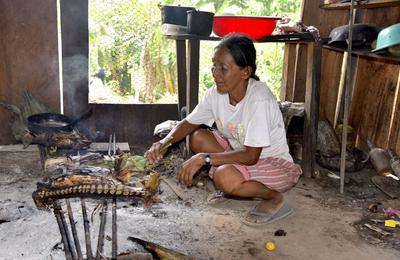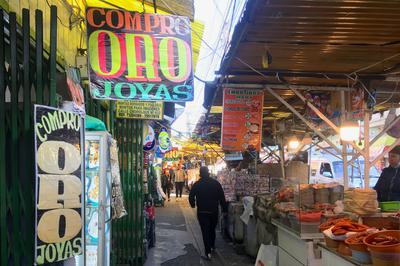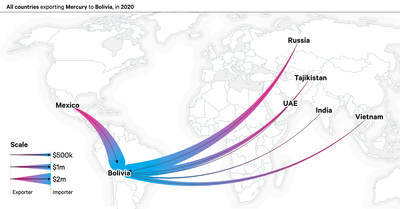Across Bolivia, even in protected areas recognized by the United Nations for their diversity of wildlife, more than 1,000 artisanal mining operations are razing trees, diverting waterways, and reshaping the land in their search for gold. While miners are making a living, though, they are also dispersing mercury through the air, water, and soil. Their use of mercury has helped propel Bolivia to become the world’s biggest importer of the toxic substance.
The Minamata Convention is a global treaty to protect human health and the environment from the effects of mercury, considered by the World Health Organization to be one of the top 10 chemicals of greatest public-health concern. The treaty is named for Minamata Bay, Japan, where industrial dumping of mercury in the 1950s and ’60s led to widespread birth defects, neurological problems, and deaths as people consumed tainted fish. Like most South American nations, Bolivia signed the convention, which came into effect in 2017 and requires countries to develop a national action plan to reduce and, where feasible, eliminate mercury use in artisanal and small-scale gold mining. But unlike other nations, Bolivia has done almost nothing to regulate the import or use of mercury.
Last year, gold was Bolivia’s top export, worth $2.5 billion — double the value in 2020.
Bolivia has long been criticized by environmental and civil society groups for its lax regulation of the element, of which the vast majority is used for gold mining. Last year, Marcos Orellana, a professor of environmental law at George Washington University who is the UN’s special rapporteur on toxics and human rights, urged the Bolivian government to take action against the mercury trade, noting that its approach “has generated serious impacts on the human rights of populations affected by mercury contamination, including members of Indigenous peoples.”
In response, Bolivia’s attorney general defended the country’s adherence to the Minamata Convention, citing pilot programs among miners to raise awareness of the effects of mercury and to promote alternative technologies. But little has changed in remote mining camps, and this past September, Orellana presented a report to the UN’s Human Rights Council that called for a global ban on trading mercury and on using it in small-scale gold mining, which is now the world’s largest source of mercury pollution. He singled out Bolivia as a reported hub for mercury smuggling to other countries in the Amazon Basin. In October, when Orellana was in La Paz, Bolivia’s capital, for a conference on mercury, two Bolivian NGOs released preliminary findings of their own mercury studies, which showed that communities downstream of mining activity have abnormal and, in some cases alarming, levels of mercury in their bodies.
Gold has long been considered a safe haven for investors and a hedge against inflation. In recent years, its price hit record highs, and the increase has driven a surge in mining. Last year, gold was Bolivia’s top export, worth $2.5 billion — double the value in 2020.
Left: Mercury is poured by miners on a clump of earth to amalgamate gold particles. Right: A lump of gold and mercury. Thomas Graham
The majority of Bolivia’s gold mining, performed by unionized mining “cooperatives” working both legally and illegally, takes place in the La Paz region, including in the mountains and forests of the Apolobamba, Madidi, and Cotapata National Parks, which lie north and northeast of the nation’s capital. In Bolivia, as in much of the Amazon, gold occurs at low concentrations in the earth and in riverbeds. Practices vary, but miners typically use heavy machinery to excavate huge amounts of material, or hoses to suck up sediment from the riverbed, then process this gold-bearing soil and water through a sluice system that concentrates the gold. The miners then add liquid mercury to a slurry of gold and sand. The metal binds with the gold, forming an amalgam. Miners discard the process water and tailings, which still contain some mercury, then heat the amalgam, vaporizing the portion that is mercury and leaving behind purer gold.
Mercury ends up in human bodies through two distinct pathways. The first is when miners, most of whom work without protective masks, vaporize mercury and inhale fumes. This may happen on the site of a mining operation or where gold buyers further refine small nuggets of ore in their shops, dispersing fumes through populated areas.
There is no single internationally accepted limit for mercury levels in humans, although the U.S. Environmental Protection Agency has set a safe limit of 1 part per million (ppm), as measured in hair samples. Mercury emissions can be human-caused or result from natural processes: the element is emitted into the air when forests burn, volcanoes erupt, and rocks weather. In 2018, the United Nations carried out a global mercury assessment and concluded that in most background populations — that is, among people without significant mercury exposure — the level tends to be less than 2 ppm.
Members of one Indigenous community reported pains in their muscles, heads, and stomachs after mining intensified upstream.
“That being said, we don’t think there’s any safe level of mercury,” said Professor Niladri Basu, an environmental toxicologist at McGill University who was part of the assessment. “There are case studies in which people will exhibit mercury in the hair lower than 2 ppm and show some sort of effect.”
Prompted by the intensification of gold mining in Bolivia in recent years, civil society groups in 2022 carried out two non-peer-reviewed studies of mercury levels in riverside populations downstream from mining activity in the Bolivian Amazon. In the Department of La Paz, the Wildlife Conservation Society and Reacción Climática took hair samples from 268 people from 27 communities and five Indigenous groups. The average mercury level of everyone tested was 2.96 ppm, while the Esse Ejja, an Indigenous group that eats much more fish than the others, averaged 6.9 ppm. This study built on a 2021 study carried out by the International Pollutants Elimination Network, which found that Esse Ejja women of child-bearing age had an average hair mercury level of 7.58 ppm. The highest level was 32.4 ppm.
Also in 2022, the Bolivian Center for Documentation and Information took 590 samples from 15 riverside communities in the two principal watersheds of the Bolivian Amazon, the Beni and the Madre de Díos. All five communities along the Beni River had an average mercury level above 2 ppm, and two had average levels closer to 7 ppm. The researchers took 112 samples from children under the age of 15 in these communities and found an average mercury level of 6.48 ppm. Meanwhile, on the Madre de Díos River, where gold mining is less intensive, all but one community had an average mercury level above 1 ppm, though none exceeded 3 ppm.
An Indigenous Chiman woman who lives along the Beni River cooks fish. AIZAR RALDES / AFP via Getty Images
Neither study collected data on the health of participants, and researchers drew no conclusions about links between poor health outcomes and mercury exposure. The levels observed were far lower than those observed in Minamata Bay, where hair mercury levels ranged from 191 ppm to 705 ppm. Nonetheless, researchers noted — and participants reported — symptoms that could be connected to mercury exposure.
“In the case of children, one of the symptoms is highly sensitive skin and a kind of pink rash on the hands and extremities,” said Oscar Campanini Gonzalez, director of the Bolivian Center for Documentation and Information. “And we observed this on the skin of various children that were nursing.” If confirmed, said Campanini, this would imply exposure to mercury either in utero or through breast milk. Oscar Lurici, a representative of the Esse Ejja, told Yale Environment 360 that adults in his community started to experience new kinds of health problems as upstream mining intensified. “They started feeling pains in their muscles, heads, and stomachs,” he said. “Sometimes, babies and the elderly have blood in their feces.”
Pál Weihe, who 30 years ago led a benchmark study on the effects of methyl mercury exposure in the Faroe Islands, where mercury-contaminated pilot whale was an important part of the diet, said that the symptoms being reported in Bolivia among adults would not be typical with this level of mercury exposure. “But if you ask me, is the level of exposure stated by these NGOs problematic? Then I would say, yes, they should definitely be brought down.”
The most urgent reason to do that, Weihe said, is to protect fetuses that can be exposed to mercury when mothers consume mercury-contaminated fish. Such exposure can have subtle but permanent neurodevelopmental effects. “Humans are more vulnerable [to toxic substances] before birth, without a doubt,” said Weihe, now chief physician at the University of the Faroe Islands. “The brain is developing. Its architecture is taking shape.”
According to Campanini, the riverside communities want a medical specialist to investigate potential links between mercury exposure and their symptoms. They also want more studies performed on fish from their rivers, to help them identify which species have lower levels of mercury. If people stop consuming mercury altogether, their levels will slowly fall, experts say, but fish consumption is otherwise highly beneficial for these populations. “It’s very difficult to weigh the neurological risk that mercury may pose against the neurological benefits of fish consumption,” said Basu.
Lurici, of the Esse Ejja, said his Indigenous group only recently found out about elevated levels of mercury in their community. “But we can’t be told not to eat fish, because that’s the community’s work, its source of food. Absolutely everyone eats fish.”
If communities can’t give up fish, can miners give up, or reduce, their use of mercury? Large-scale miners often use cyanide to leach gold from ore, but the chemical is also toxic to humans and wildlife. The Bolivian foundation Medmin, which works with miners to improve their environmental practices, and other NGOs have worked with 15 mining cooperatives to adopt technologies that prevent mercury pollution by reducing the quantity used and then recycling it. According to Danilo Bocángel Jerez, general manager of Medmin, miners can concentrate the gold as much as possible before adding mercury, then heat their amalgam in a closed system that captures and then reliquefies vaporous mercury for reuse.
In 2021, the government announced it would produce an action plan for mercury use in July of 2022. The plan has yet to appear.
In theory, such technologies could reduce mercury loss to near zero, and the NGOs are hoping the cooperatives they work with will pass these lessons to others. But there are 1,400 mining cooperatives in La Paz, and more appear every year. They operate in remote locations, often without environmental licenses and sometimes without legal concessions. The government, said Marcos Uzquiano, until recently the head of protection at Madidi National Park, mostly turns a blind eye to these operations. And if it does levy a fine, the miners pay it and keep working.
Most miners, said Alfredo Zaconeta Torrico, a mining expert at CEDLA, a Bolivian think tank, are unlikely to adopt such technologies of their own volition because they are used to working with mercury and are unwilling to make the investment. Moreover, the economic incentive to reuse mercury is small. “Compared to what they are earning with gold, the price of mercury is nothing,” said Zaconeta.
Another way to reduce mercury use would be regulating it at the point of import. Zaconeta said every importer of mercury should be required to state where it will end up, and if it will be used in mining, what environmental practices will be used. Even if such regulations were flouted, he said, they would increase the price of mercury and incentivize miners to reuse it. According to Campanini, the Ministry of Environment presented such a proposal to the Bolivian Cabinet several times in recent years, but the idea was never pursued.
Exports of mercury to Bolivia in 2020 by value in U.S. dollars. Chatham House
Fecoman, the union of cooperative gold miners in La Paz, has said it is open to changing technologies, but only if the government pays for it. In the past, the union has blocked proposed mercury regulation by shutting down traffic in the nation’s capital. Last year, gold exports represented 6.2 percent of Bolivia’s GDP.
In 2021, after UN rapporteurs submitted a 10-page letter to the Bolivian government citing the lack of regulation of mercury and human rights violations against Indigenous peoples, and suggesting the country was in breach of the Minamata Convention, the government announced it would produce an action plan for mercury use in July 2022. The plan has yet to appear, though officials insist it is in the works.
“We just want some support from the government,” said Oscar Lurici, of the Esse Ejja. “Maybe they could help people find [alternatives to] fishing. Or perhaps help them raise their own fish” on land, something the government has supported as a development strategy elsewhere in Bolivia. Campanini said further studies could also help communities like the Esse Ejja identify which fish, from where, have lower levels of mercury and are safer to eat.
For now, the Ministry of Health has created a toxicology network, which it says has more than 100 doctors monitoring for symptoms of mercury poisoning in areas affected by gold mining. The ministry did not respond to a request for an interview. “The creation of this network shows some kind of attention on the part of the state,” said Campanini. “But it’s certainly not the national action plan required by the Minamata Convention.”
